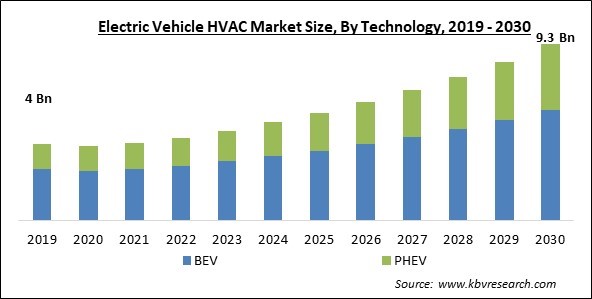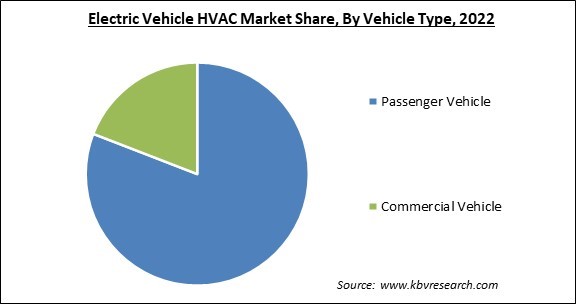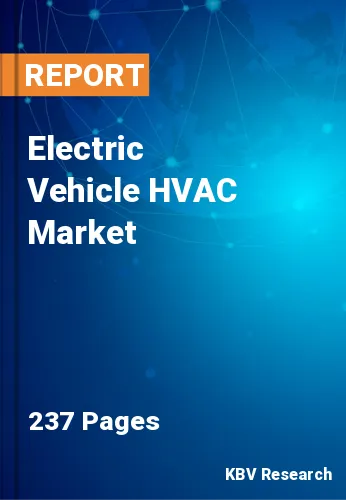The Global Electric Vehicle HVAC Market size is expected to reach $9.3 billion by 2030, rising at a market growth of 10.1% CAGR during the forecast period.
Technological advancements, particularly in battery technology, enable rapid electrification of trucks, buses, and other non-passenger vehicles. Consequently, the Commercial Vehicle segment would generate approximately 19% share of the market by 2030. The International Energy Agency (IEA) reported that more than 2.1 million electric cars were sold in 2019, representing nearly 2.6% of global car sales. In 2019, they also represented approximately 1% of the worldwide car stock, a 40% year-on-year increase compared to 2018. Original equipment manufacturers in developing regions, like China, India, and Japan, are adjusting to the shifting regional and segment trends in supply and demand concerning their production & supply base footprints, supply chains, and range of products. Moreover, urbanization and population growth enhance consumer demand for vehicles. Some of the factors impacting the market are environmental effects of HVAC system refrigerants, increasing demand for automobile thermal systems and automatic climate control, and high HVAC maintenance, repair, and installation expenses.

In the HVAC system of a car, the refrigerant is essential. Refrigerants such as hydrofluorocarbons, chlorofluorocarbons, and hydrofluoro-olefins (HFO) are used in the vehicle HVAC system. However, these refrigerants have a tendency to cause global warming (GWP), are detrimental to environmental sustainability, and may contribute to ozone depletion. For instance, the Minimum Energy Performance Standards (MEPS) levels in Australia are necessary specifications in the appropriate Australian Standards for certain items (such as air conditioners, refrigerators, and freezers) manufactured in or imported into Australia. One of the most crucial aspects to consider when buying a car is the thermal comfort inside. The HVAC system's installation ensures that both the driver and the passenger are in a comfortable temperature environment. The HVAC system enhances the temperature environment and increases air conditioning efficiency, lowering fuel usage. By switching from a positive temperature coefficient (PTC) heater to a heat pump-based system, for instance, an average energy savings of 17% to 52% can be made during cabin heating. As a result, the market is anticipated to rise favorably as HVAC systems based on heat pumps become more widely used.
However, System failures brought on by poor maintenance can be expensive to fix or replace. The high cost of HVAC system maintenance is partly a result of the high price of replacement parts. HVAC system repairs can be pricey due to the high cost of replacement parts. Additionally, particularly with older HVAC systems, the accessibility of substitute parts can be problematic. The cost of the automobile will increase as a result of the large quantity that must be spent. The high price of HVAC systems could limit market expansion in the coming years.
Based on vehicle type, the market is segmented into passenger vehicle and commercial vehicle segments. In terms of revenue, the passenger vehicle segment dominated the market in 2022. The passenger car segment comprises vehicles for conveying people, such as compact cars, hatchbacks, sedans and luxury sedans, among others. Major global actors focus on passenger automobiles and luxury vehicles such as SUVs. Increased consumer disposable income and the production and sale of four-wheeled vehicles are responsible for incorporating HVAC systems in passenger automobiles. Principally automatic and manual technologies are utilized in passenger vehicles manufactured by industry leaders.

Based on technology, the market is segmented by technology into BEVs and PHEVs. In 2022, the BEV segment held the largest revenue share. To increase the driving range of BEVs, it is essential to install HVAC systems that minimize energy consumption while maximizing comfort. Optimized HVAC technologies can alleviate range anxiety, a significant concern among prospective BEV buyers. Furthermore, the demand for BEVs is driven by stringent emission standards and supportive policies encouraging the adoption of electric vehicles.
Based on component, the market is segmented into compressor, condenser, heater core, evaporator, and others. In 2022, the compressor segment captured a significant revenue share of the market. Independent of the vehicle's engine, an electric compressor is responsible for chilling the interior and battery pack and safeguarding the battery from overheating to prevent vehicle failure. Given that electric compressors are completely independent of the vehicle's engine, all of these benefits contribute to the improvement of the vehicle's overall efficiency, thereby fueling the demand for such compressors.
| Report Attribute | Details |
|---|---|
| Market size value in 2022 | USD 4.4 Billion |
| Market size forecast in 2030 | USD 9.3 Billion |
| Base Year | 2022 |
| Historical Period | 2019 to 2021 |
| Forecast Period | 2023 to 2030 |
| Revenue Growth Rate | CAGR of 10.1% from 2023 to 2030 |
| Number of Pages | 237 |
| Number of Table | 350 |
| Report coverage | Market Trends, Revenue Estimation and Forecast, Segmentation Analysis, Regional and Country Breakdown, Companies Strategic Developments, Company Profiling |
| Segments covered | Technology, Component, Vehicle Type, Region |
| Country scope | US, Canada, Mexico, Germany, UK, France, Russia, Spain, Italy, China, Japan, India, South Korea, Singapore, Malaysia, Brazil, Argentina, UAE, Saudi Arabia, South Africa, Nigeria |
| Growth Drivers |
|
| Restraints |
|
Based on regions, the market is analyzed across North America, Europe, Asia Pacific, and LAMEA. Asia Pacific dominated the market in 2022 by generating the largest revenue share. China's demand for electric buses keeps rising, and many cities now operate electric fleets entirely. Under Phase 2 of the FAME (Faster Adoption and Manufacturing of Electric Vehicles) scheme, the procurement of electric vehicles, particularly for public transportation in India, has been accelerated. Consequently, such factors continue to fuel the demand for electric vehicles, which will, in turn, drive market expansion in this region.
Free Valuable Insights: Global Electric Vehicle HVAC Market size to reach USD 9.3 Billion by 2030
The market research report covers the analysis of key stakeholders of the market. Key companies profiled in the report include Valeo SA, Hanon Systems (Hahn & Co. Auto Holdings Co., Ltd.), Toyota Industries Corporation, Mahle GmbH (Mahle Stiftung GmbH), Panasonic Holdings Corporation, Johnson Electric Holdings Limited, Sanden Corporation (Hisense Home Appliances Group Co., Ltd), Marelli Holdings Co., Ltd., Denso Corporation, and Brose Fahrzeugteile SE & Co. KG.
By Technology
By Component
By Vehicle Type
By Geography
This Market size is expected to reach $9.3 billion by 2030.
Environmental Effects of HVAC System Refrigerants are driving the Market in coming years, however,High HVAC Maintenance, Repair, and Installation Expenses restraints the growth of the Market.
Valeo SA, Hanon Systems (Hahn & Co. Auto Holdings Co., Ltd.), Toyota Industries Corporation, Mahle GmbH (Mahle Stiftung GmbH), Panasonic Holdings Corporation, Johnson Electric Holdings Limited, Sanden Corporation (Hisense Home Appliances Group Co., Ltd), Marelli Holdings Co., Ltd., Denso Corporation, and Brose Fahrzeugteile SE & Co. KG.
The expected CAGR of this Market is 10.1% from 2023 to 2030.
The Condenser segment is leading the Market by Component in 2022; thereby, achieving a market value of $2.8 Billion by 2030.
The Asia Pacific region dominated the Market by Region in 2022, and would continue to be a dominant market till 2030; thereby, achieving a market value of $3,653.8 Million by 2030.
Our team of dedicated experts can provide you with attractive expansion opportunities for your business.

